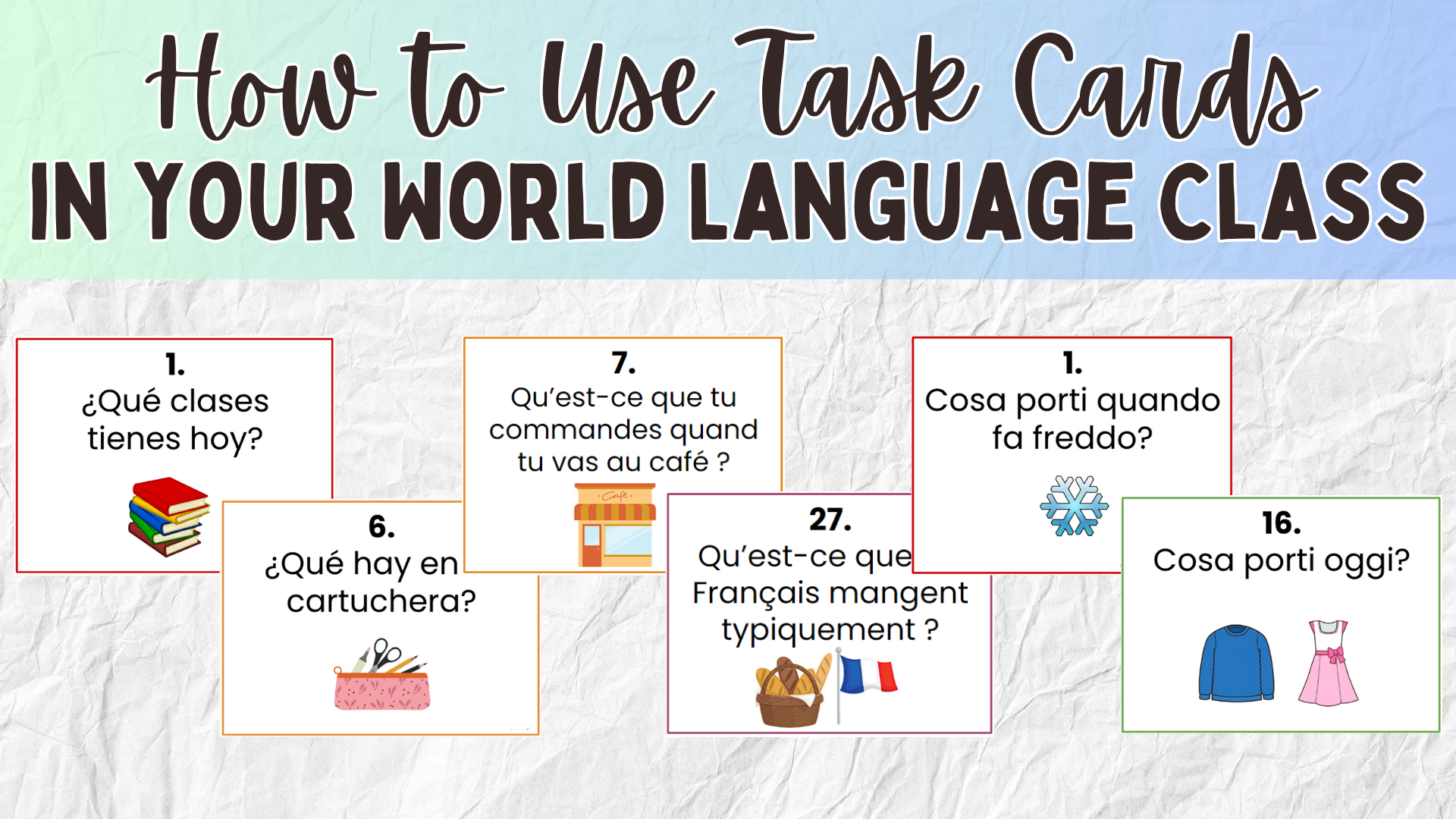
The Importance of Music in the World Language Classroom
Music is a powerful tool in the World Language classroom that helps students connect with language on a deeper level. It supports listening comprehension, pronunciation, and vocabulary retention in a way that feels natural and engaging. Songs also provide valuable cultural context, offering a glimpse into the lives, values, and expressions of native speakers. Because music is fun and emotionally resonant, students often participate more willingly and remember what they’ve learned without even realizing it. Incorporating music into lessons brings language to life and creates an immersive, joyful learning experience.

How to Stay Inspired in Your Teaching Practice
Feeling a bit stagnant or stuck in your teaching practice? Looking to change things up a bit so that you feel creatively and professionally energized? In this blog post, I discuss ways to stay inspired with the lessons you are presenting your students. Whether you’re looking to tweak and freshen up just a couple lessons or interested in completely overhauling a unit or two over the summer, I’ve got practical tips to help you get started.

Low-prep Vocabulary Activities for French, Spanish, Italian
With vocabulary being such a critical pillar of language learning, it’s essential that we go beyond rote memorization and find creative, low-pressure ways to help students engage with words repeatedly. The more meaningful and varied the exposure, the more likely students are to retain the vocabulary long-term. Whether it’s through movement, visuals, storytelling, or games, these types of activities not only boost word exposure but also increase student motivation and participation. By incorporating fun, hands-on (LOW-PREP!) vocabulary practice into your regular routines, you’re giving students multiple opportunities to internalize new words without it feeling like a chore. The result? Better retention, stronger performance, and greater confidence as they build toward fluency.

Setting Intentions for the New School Year
As a new school year begins, it’s the perfect time for teachers to reflect and set meaningful intentions. Rather than getting swept up in the hustle, take a moment to ask yourself what kind of energy you want to bring into your classroom. Setting clear intentions can help you stay grounded, focused, and aligned with your core values—especially when things get hectic. Whether it's fostering more joy, building stronger student connections, or protecting your own boundaries, your intentions can guide your daily choices. Start small, stay consistent, and let those intentions shape a year that feels purposeful and empowering.

French, Spanish, and Italian Full Year Curriculum
When I began my teaching journey, I faced a daunting challenge: inadequate resources and outdated materials that left me struggling to engage my language learners. Many World Language teachers can relate, whether struggling with a lack of district-provided curriculum or sudden shifts in teaching assignments. Novice teachers feel overwhelmed, mid-career educators find themselves starting anew, and even veteran teachers seek fresh ways to inspire today's students. Reflecting on my early days in the classroom, I realized the need for comprehensive, engaging World Language Curriculum Bundles. In this post, I'm excited to introduce my French 1, Spanish 1, and Italian 1 Curriculum Bundles—meticulously crafted resources that I wish I had when I started teaching, designed to empower World Language teachers with everything they need to foster meaningful language learning experiences for their students.

How to Use Task Cards in Your World Language Class
Getting our students to write and speak the target language more regularly is challenging, especially at the lower levels. Writing and speaking tend to be the proficiency domains that are the last and usually slowest to develop, so it’s no wonder that students find it challenging and seek to avoid it at all costs. In this post, I share a resource that I always use in my World Language classroom: Task Cards! I’ll walk you through how to prep and implement your task card activity to help your students improve their written and spoken language fluency while recycling vocabulary and grammar from your current unit as well as previously studied units!

Should World Language Teachers Assign Homework?
Should you assign homework in your World Language class? While the answer isn't simple, this blog post will help guide you through the pros and cons of assigning homework in your French, Spanish, or Italian classes. I’ll share my own perspective as a teacher who uses homework as a reinforcement tool, provide key questions to help you decide whether or not homework is appropriate for your classroom, and highlight effective homework practices that support student learning.

Using Incentives and Rewards to Increase Motivation and Improve Classroom Management
Engaging students in today’s classroom feels harder than ever. From the lingering effects of distance/hybrid learning to the constant distraction of social media and technology, the challenges are real—but so is the potential for creative solutions. In this blog post, I’ll share how I’ve transformed my World Language classroom by using simple, low-cost rewards and incentives. These strategies not only motivate students but also bring excitement and energy to our daily lessons. Plus, I’ll offer practical tips for reaching even the most reluctant learners. If you’re ready to spark joy and engagement in your classroom, this post is for you!

French, Spanish, Italian Indefinite and Definite Articles
Teaching indefinite and definite articles in French, Spanish, or Italian can feel like a routine grammar drill, but it doesn't have to be! What if you could turn this essential lesson into an engaging, dynamic experience that resonates with your students? In this post, we’ll explore practical lesson plan ideas and strategies for introducing articles, nouns, and gender (masculine vs. feminine) in French, Spanish, and Italian, providing students with ample practice opportunities, and assessment ideas to ensure your students have mastered the concept. And the best part? All the work has already been done for you—click to read more!

Beat End-of-Marking Period Teacher Stress and Burnout!
The end of the marking period can feel like a full-on sprint with no finish line in sight—piles of grading, looming deadlines, and zero time to prep for what’s next. If you’re running on caffeine and sheer willpower, you’re not alone. In this post, I’m sharing my tried-and-true strategies for minimizing stress, protecting your peace, and actually making it through grading season without losing your mind!
